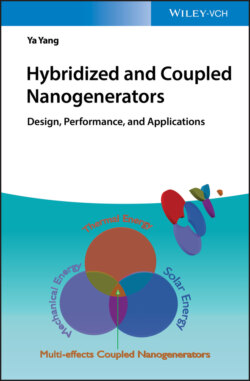Читать книгу Hybridized and Coupled Nanogenerators - Ya Yang - Страница 16
1.3.1 Pyroelectric and Photovoltaic Coupled Nanogenerators
ОглавлениеSome ferroelectric materials have both pyroelectric and photovoltaic properties such as LiNbO3 [34–36], Pb(Zr,Ti)O3 (PZT) [37–39], BaTiO3 (BTO) [40–42], and BiFeO3 [43–45]. Owing to the wide bandgaps of about 2.7–4 eV, these ferroelectric materials are more suitable to be used as photodetectors instead of as solar cells. When the light is illuminated on the ferroelectric materials, the light‐induced heating can generate pyroelectric current, and photovoltaic current can be also observed. The pyroelectric and photovoltaic coupled nanogenerators are based on understanding the mechanisms about how to couple the two current/voltage signals in the ferroelectric materials.
Here, we used the ferroelectric BaTiO3 material as an example to describe the pyroelectric and photovoltaic coupled nanogenerators [46]. The Ag and ITO were utilized as the bottom and top electrodes of the device, respectively. As illustrated in Figure 1.7a, there will be no current signals when the dT/dt = 0, where T is the temperature and t is the time. The reason is that there is no change of the polarization in the BaTiO3 material, so that no output current signals can be seen in the external circuit. When the temperature variation dT/dt is larger than zero, the corresponding polarization in the BaTiO3 material will be decreased, indicating that the electrons in the external circuit can move from the bottom Ag electrode to the top ITO electrode to deliver a pulsed output current signal. The pyroelectric current signals are AC signals, which can only flow in the external circuits.
For the photovoltaic effect, the spontaneous polarization‐induced electric field can effectively drive the light‐induced electrons and holes to separate and flow to the two electrodes, as displayed in Figure 1.7b. Owing to the built‐in electric filed in these ferroelectric materials, only one material can realize the appearance of photovoltaic current instead of p–n junctions. As depicted in Figure 1.7c, the pyroelectric effect induced by light illumination can modulate the charge transfer processes of the light‐induced electrons and holes such as generation, separation, and recombination. As a result, the coupling enhancement “1 + 1 > 2” for the output current signals can be seen in this system due to the coupling effect between the pyroelectric current and the photovoltaic current signals. The new physical effect of ferro–pyro–phototronic effect can be found in this process.
